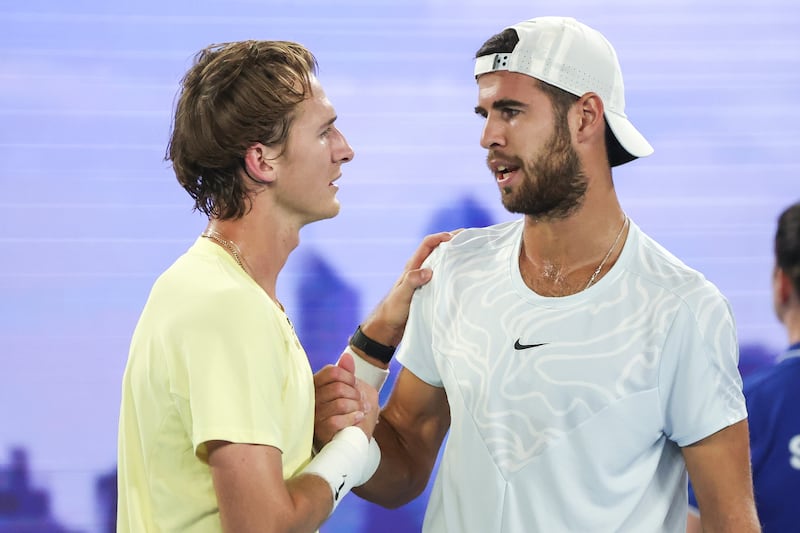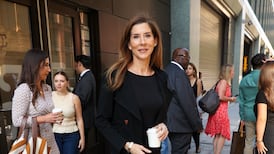Karen Khachanov continued his career resurgence by moving into his second consecutive grand slam semi-final at the Australian Open on Tuesday, but even as he marches through the draw, his message has commanded as much attention as his tennis.
Khachanov advanced past Sebastian Korda after the American retired with a right wrist injury when trailing 7-6 (5), 6-3, 3-0.
During his wins over Frances Tiafoe and Yoshihito Nishioka, Khachanov signed the camera by writing “Stay strong, Artsakh”, referring to the blockade of the disputed territory between Armenia and Azerbaijan, which is also known as Nagorno-Karabakh, since mid-December. Khachanov’s father, Abgar, is from Armenia’s capital city, Yerevan.
After the quarter-final, Khachanov reiterated his support, although he declined to elaborate: “I have Armenian roots,” he said. “From my father’s side, from my grandfather’s side, even from my mom’s side. I’m half Armenian. I don’t want to go deeper than that and I just wanted to show strength and support to my people.”
READ MORE
Khachanov’s support shines further light on a territorial conflict between Armenia and Azerbaijan that has taken place for more than 30 years. The most recent significant conflict, the 44-day war, occurred in 2020, when 6,800 soldiers died.
After the ceasefire agreement, thousands of Russian peacekeeping forces were deployed along the Lachin corridor, the only road linking Armenia with the territory and where supplies are transported to the mountainous region from Armenia.
For more than 40 days, Azeri protesters have blocked the road, halting the transportation of goods, food and medical supplies to Nagorno-Karabakh. The Armenian government has said the protesters were dispatched by Azerbaijan’s government. Azerbaijan disputes there is a blockade.
[ Australian Open: Azarenka sets up semi-final showdown with RybakinaOpens in new window ]
In a letter to the International Tennis Federation (ITF) on Tuesday, the Azerbaijan Tennis Federation demanded Khachanov receive punishment for his message: “Writing heartfelt wishes on the camera lens is a kind of tradition in tennis, but Khachanov abused this, using it in his dirty plans.”
Khachanov did not mention Azerbaijan in any of his messages and said he had not received any message from the ITF or discouragement from anyone.

As the All England Club contemplates whether to extend their ban of Russian players after the invasion of Ukraine, Khachanov was asked if he had any message for the club. “Just whatever they decide. I mean, what can I do? My words would not change anything.”
Khachanov opened the contest with Korda in top form, taking the opening set by ending a 17-stroke rally with a crushing down-the-line backhand winner. Korda’s forehand appeared vulnerable in the early stages but by the second set it was clear he had a problem. The American took a medical timeout for his right wrist at 3-2 in the third set and after conceding seven games in a row, he retired in the third set.
Of the three players from Russia ranked inside the top 20, it was Khachanov, the least celebrated, who broke through before them all. He established himself by winning his first Masters 1000 title at the Paris Masters in November 2018, beating Novak Djokovic in the final. Instead of the achievement marking a career stepping stone, though, he languished.
As Andrey Rublev, now 25 years old, and Daniil Medvedev, now 26, fully established themselves at the top of the game, Khachanov, also now 26 years old, fell out of the top 20 in February 2020 and remained there until last September when he reached his first grand slam semi-final at the US Open.
[ Back from the break, the incredible resurfacing of Andy MurrayOpens in new window ]
While Khachanov lacks the clean shotmaking and timing of young talents such as Korda, he has built a reliable, effective game. At 6ft 6in, he pairs his big first serve with solid defence, high-octane, high-percentage ball striking and a great work rate. Despite his height and stature, he has excelled by outworking elite opponents rather than hitting them off the court.
His discipline and industriousness was most evident in the quarter-finals of last year’s US Open when he outlasted Nick Kyrgios in five tense sets, blunting Kyrgios’s flashy shotmaking to reach the semi-finals. In Australia, he will return to the same stage, this time hoping for more. – Guardian














